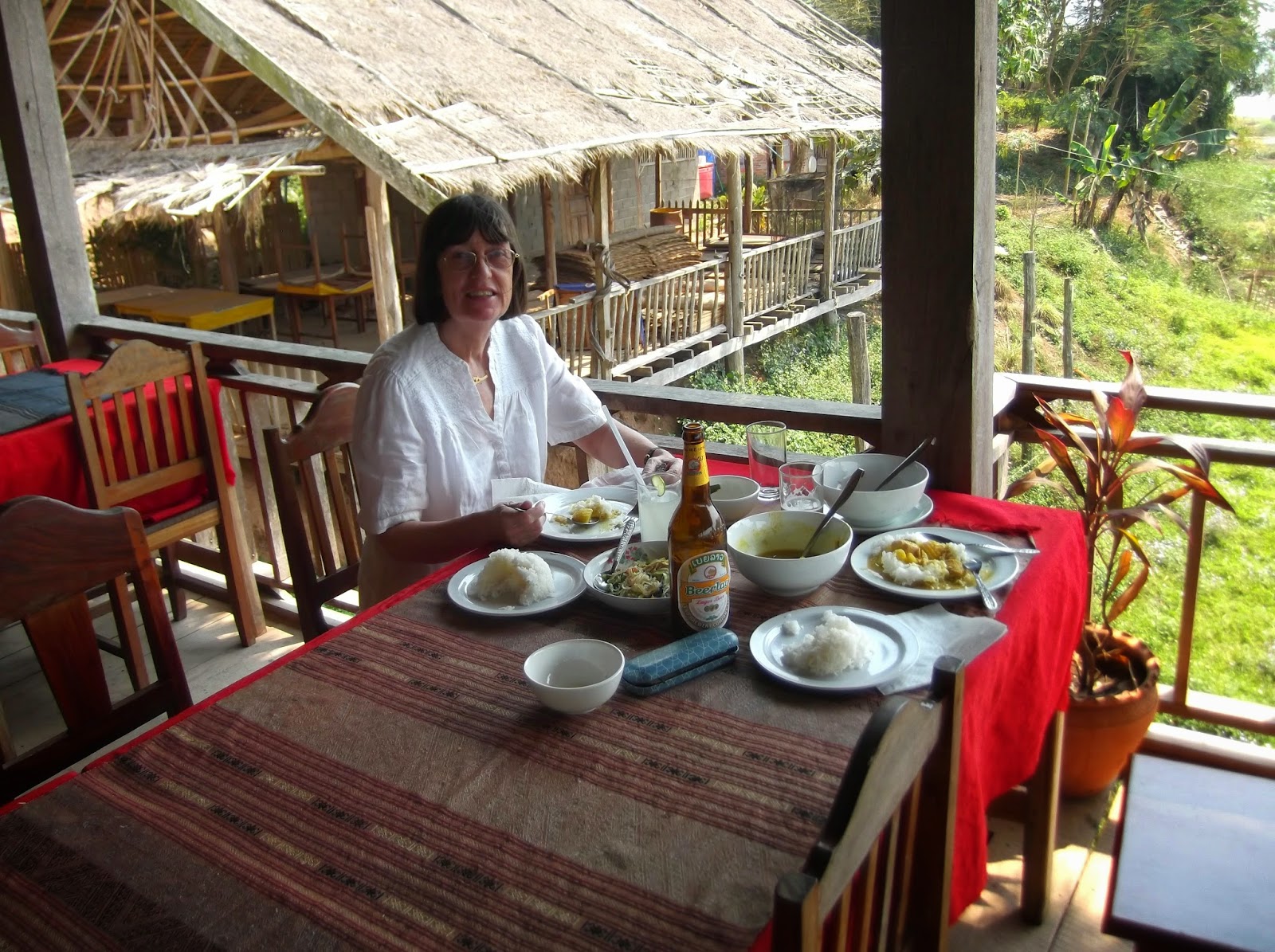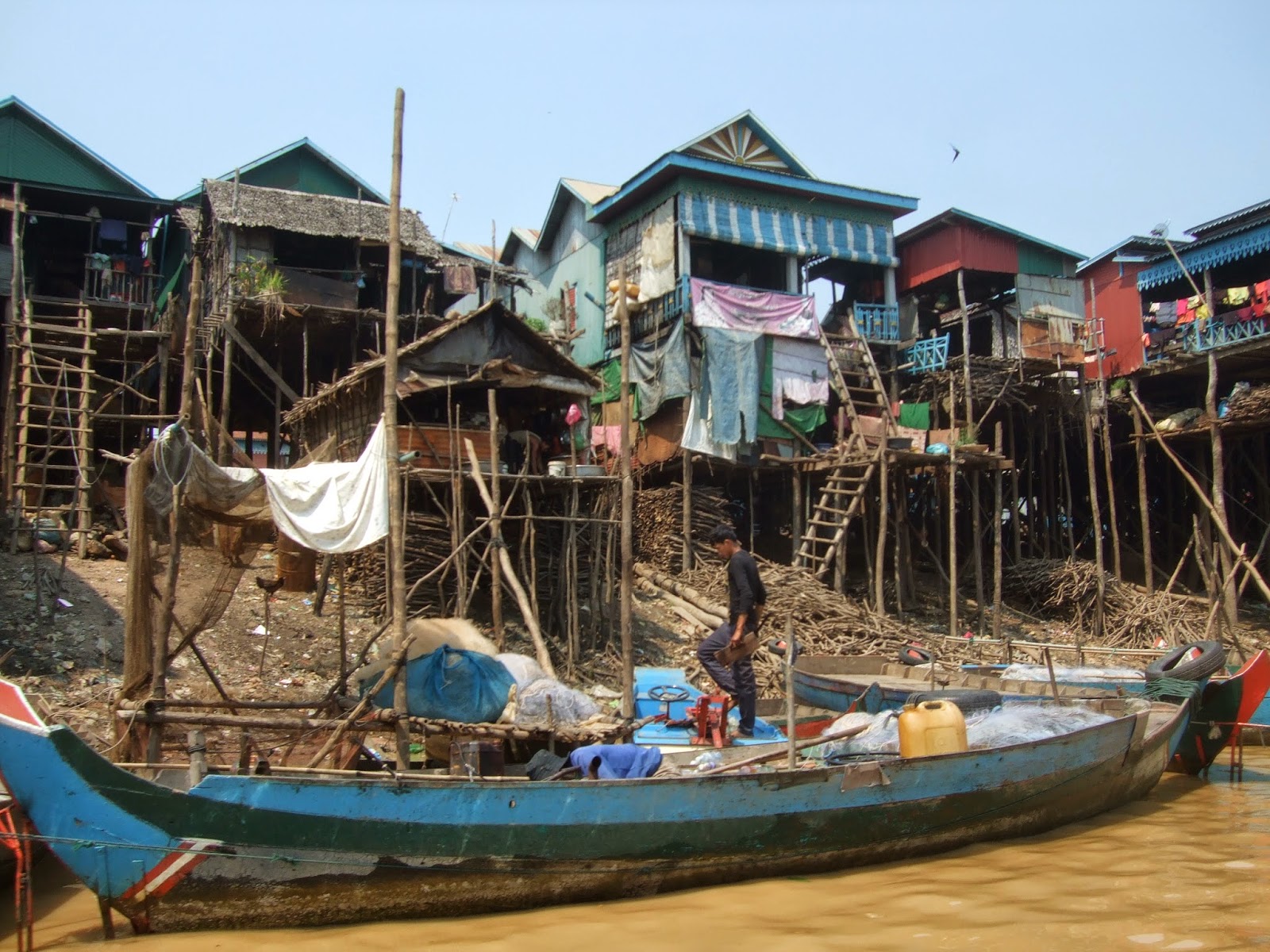A Boat Trip up the Mekong: Rice Wiski and a Cave of Buddha Images
But First, A Little Orientation
 |
| Laos |
 |
| South East Asia. Luang Prabang was our most northerly point in this trip |
Boarding an Overlarge Boat, Luang Prabang
Next morning we walked down to the river bank and embarked on yet another in our series of grossly over-sized boats. These monsters – they can seat a dozen or so - were doing good business, though four passengers were the most we saw on any of them.
 |
| Over-sized boats, Luang Prabang |
They are made even longer by the living quarters of the boatman and his family which form a large part of the stern.
 |
| Lynne has plenty of space |
Upstream from Luang Prabang
As we left, N pointed out the hill on the far side of the river. Just about everywhere has a hill from which unrequited lovers are
reputed to leap. This, apparently, is Luang Prabang’s but the rounded green
hills would not seem to offer much scope to the suicidally inclined.
 |
| Lover's Leap, Luang Prabang - well, up there somewhere |
We pottered gently upstream. The Mekong here is broad, though much narrower than the mighty river it was just north of the delta, but not very deep.
 |
| Heading up the Mekong from Luang Prabang |
The boatman skilfully rounded shoals and rocky islets, slid gracefully over turbulent sections - not quite rapids - and through nascent whirlpools while his wife sat silent and motionless in one of the rear seats. She did that all day.
 |
| The boatman skilfully rounds the shoals and rocky islands.... |
The sun shone, the breeze over the water was refreshing, the hills were shrouded in mist and the banks were lush and verdant. All seemed right with the world.
 |
| Trees cling to the bank, The Mekong River above Luang Prabang |
Ban Xang Hai, Rice Wiski and Other Delights
After a couple of hours the boatman turned towards towards the east bank where a set of steps led up into the jungle.
 |
| The mooring at Ban Xang Hai |
We moored against a couple of
earlier arrivals, climbed the steps and found ourselves in the
'whisky village' of Ban Xang Hai. I have chosen the Scottish spelling of whisky, though with little justification. On the labels the spelling
is 'wiski', though the residents of Tomintoul, Tullamore or Tennessee might
experience some difficulty in recognising the product as whisk(e)y of any sort.
 |
| Ban Xang Hai Lao Rice Wiski |
Rice is boiled, soaked and sweetened, yeast is added and the whole thing allowed to ferment. There is more than enough sugar to take the
resulting rice wine up to 15% alcohol, at which strength the yeast dies off.
A 'white wine' is made from ordinary rice and a red from 'sticky' rice. Both are sweetish, the white retaining a little acidity and the
red tasting as though some fruit had been added.
 |
| Lynne tastes the 'white wine' |
Some rice wine is sold as such, the rest is distilled. The still is basic, the vapour cooled by sticking a hose into the bath at the
top. The product is 55% alcohol and from sucking my finger after dipping it in
the stream of warm distillate, I know it is a strong clean spirit.
 |
| Wiski still, Ban Xang Hai |
Bottled and aged - or at least allowed to cool - the spirit becomes more complex with a flavour that lingers for hours (and tends to
repeat on you).
After making a few purchases we tore ourselves away from the distillery and found that Ban Xang Hai is a larger village than we had thought.
There were plenty of visitors and they all filed past the usual array of textile stalls. No-one seemed to be buying but business could not
have been that bad, judging by the satellite dishes sprouting from almost every house.
 |
| Satellite dish, Ban Xang Hai |
I doubt many Europeans were attracted to the medicine shop, where wiski is bottled with various allegedly strength giving additives. I have no objection to snakes, scorpions and geckos finding their way into the jars, if people imagine it will do them good, but the one on the right in the photograph contains bears’ feet and I cannot approve of that.
 |
| Medicine shop, Ban Xang Hai |
After the shops we descended a second set of steps and found our boat had moved to this end of the village to pick us up.
Pak On, Buddha Caves and Lunch
Forty-five minutes further upstream the On River joins the Mekong. Opposite the confluence are the Pak On (mouth of the On) Caves.
 |
| Pak On Cave, Mekong River |
Climbing up the concrete steps from the landing stage we entered the lower cave (Tam Ting) which is packed with Buddha images. The cave is not big, and the images are not in the best of conditions. Buddha images cannot be thrown away but when they are damaged, riddled with woodworm, or merely superseded they are sent here to live out a peaceful retirement. Compared to the spectacular Buddha cave at Pindaya in Myanmar it was nothing special and we could not be bothered to walk up the next flight of steps to the upper cave which, N assured us, was bigger but less interesting.
 |
| Part of the collection of retired Buddha images, Pak On Caves, Mekong River |
Opposite, on the neck of land at the confluence, was a restaurant on stilts. We landed on the sandy shore and climbed the steps to the huge open-sided barn which had attracted less than a dozen other lunchers. The beef stew and chicken curry with rice were both excellent but they were served with a plate of Chinese-style mixed vegetables which were pleasant enough in themselves, but belonged in an entirely different meal.
 |
| Lunch opposite the Pak On Caves |
Still, the inevitable Beer Lao was good and the view was fabulous.
 |
| A warm day, a fine view, a Lao Beer... |
As we were about to leave a group of elephants appeared bearing tourists towards the confluence. The riders dismounted and we passed them as they were making their way up to the restaurant.
 |
| Here come the elephants.Near the confluence of the River On with the Mekong |
Downstream back to Luang Prabang
The journey downstream was pleasant if inevitably quicker than the journey up.
 |
| Returning to Luang Prabang, Sometimes the stress of it all just wears me down |
Chitdara Villa, Luang Prabang
We arrived back in time to sit on our balcony as the sun went down, drink another Beer Lao and write up the notes on which this blog is based. We also popped out to photograph the back of our hotel from the garden...
 |
| The rear of the Chitdara Villa, Luang Prabang |
...and also this butterfly, which stubbornly refused to open it wings for the camera, but is still beautiful. I am fairly confident it is a Eurema, but which of the 70 Eurema species is another matter. Eurema Andersonii (One-spot Grass Yellow), I think, but it could be Simulatrix, or possibly....
 |
| Eurema Andersonii(?) Villa Chitdara garden, Luang Prabang |
Later we went out to visit a restaurant I had earmarked earlier, but due to my incompetence we sat down at a different, though superficially similar, establishment a few doors away. I was disappointed when I read the menu, but did not immediately realize why. Lynne ordered a full meal for the first time for days; spaghetti bolognese may be comfort food, but it is real food and it was good to see the doctor's pills and potions were working. I had a red curry which is as Lao as it is Thai; the two peoples are closely related and speak similar languages which they write in not quite the same alphabet. I enjoyed it, but was beginning to feel just a little riced-out.
Part 8: Siem Reap (2) Angkor Thom and Other Temples
Part 9: Siem Reap (3) Tonle Sap Lake
Part 10: Luang Prabang (1) The Old Town
Part 11: Luang Prabang (2) Back on the Mekong
Part 12: Luang Prabang (3) Elephants
Part 13: Luang Prabang to Phonsavan
Part 14: Phonsavan, the Plain of Jars and UXO
Part 15: Vientiane (1) Wats, Stupas and a Heavy Buddha
Part 16: Vientiane (2) A Buddha Park and a Fond Farewell
























































